Tips from Animal Behaviourist Mark Vette to raise a happy, sociable cat
Cats may be independent creatures, but they can also be highly sensitive—and a kitten that doesn’t have the right early experiences, or that doesn’t feel safe or secure in their home, can develop lasting anxiety.
The good news? With the right early experiences, environment, and interactions, you can help your kitten grow into a calm, confident cat who’s at ease in their surroundings.
Here world-renowned Animal Behaviourist Mark Vette shares how to prevent anxiety in cats—it all starts in kittenhood!
1. Understand the critical Formative Period
Cats have a narrow and important formative period between 3–9 weeks of age - it is the most critical window in a cat’s emotional, social and behavioural development. During this time, a kitten learns who their family is, what the world is like, and how to respond to everyday experiences. A well-socialised kitten during this stage is far more likely to grow into a confident, affectionate adult cat. Little or no exposure to humans in this time can cause them to become unsocialised and scared of humans and other novel stimuli normally found in your home.
Key exposures during this time include:
- Gentle handling and contact with people of all ages
- Positive interactions with friendly dogs and other animals
- Safe car rides and time in a crate
- Household sights, sounds, and smells
- New surfaces and play experiences
- Wearing a harness
If your kitten is still with the breeder during this time, ask them to provide lots of gentle handling, and try to visit regularly for cuddles and bonding.
Positive experiences during this time will help your cat grow into a sociable, relaxed adult who can handle travel, vet trips and catteries. A lack of exposure—or frightening experiences—can lead to lifelong fear and avoidance.

Mark Vette is a world-renowned Animal Behaviourist, Zoologist and Trainer. He brings together a unique combination of academic studies with 40 years of applied clinical animal behaviour consulting and treatment. Mark is a member of the International Association of Animal Behaviour Consultants. This article was written by Mark and the views expressed are his own.
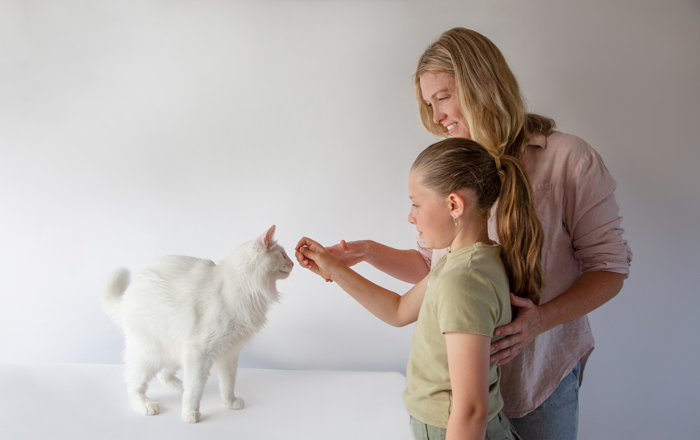
2. Socialise gently, not forcefully
Cats don’t thrive on forced introductions. They need time to investigate new things and people at their own pace.
Encourage gentle, gradual socialisation by:
- Allowing your kitten to approach new people or environments on their terms
- Cat bonding is best done by scratching the cheek of the cat first
- Using toys or treats to create positive associations
- Avoiding loud noises, restraint, or sudden movements that may startle them
If your cat is hesitant, don’t push—patience builds confidence far more effectively than pressure.
3. Avoid early frights
While exposure is critical, negative experiences can be just as powerful—in the wrong direction. It can take around five positive experiences to outweigh one negative experience!
Avoid:
- Rough handling by children
- Loud scolding or punishment
- Forcing your puppy into situations they’re not ready for (like a crowded dog park)
- Throwing them into water to “teach” swimming
- Interactions with mal-socialised dogs
Instead, gently introduce new things, and always associate them with treats, toys, and fun. If your pup gets scared, help them bounce back with calm encouragement - jolly them along!
4. Build a bond
A strong bond helps your cat feel secure, which lowers their stress levels and prevents behavioural issues. Use affection, play, clicker training, and food to build that bond.
Hand feeding is especially powerful. Offering tasty treats like cooked chicken can increase trust and connection—particularly helpful for shy or nervous kittens, or when introducing them to new family members.
5. Gradually introducing handling and grooming
Start gently handling your kitten’s paws, ears, mouth, and body early on, using treats and praise to build positive associations. This will help prevent fear of:
- Vet exams
- Grooming tools
- Nail trimming
- Medication administration
Take it slow, keep sessions short, and always pair handling with something your cat enjoys, such as play or treats (or both!).
Most cats enjoy being stroked in specific areas—usually around the cheeks, base of the ears, and under the chin. These areas contain scent glands and touching in these places can stimulate calm, friendly behaviour - so start here, then gradually teach your kitten to enjoy handling in other parts of the body too.
If you see stress indicators - such as tail flicking or thumping, ears flattening, sudden escape or lashing out - then ease off. By respecting these signals, you help your cat feel safe and in control—two key ingredients in preventing anxiety.
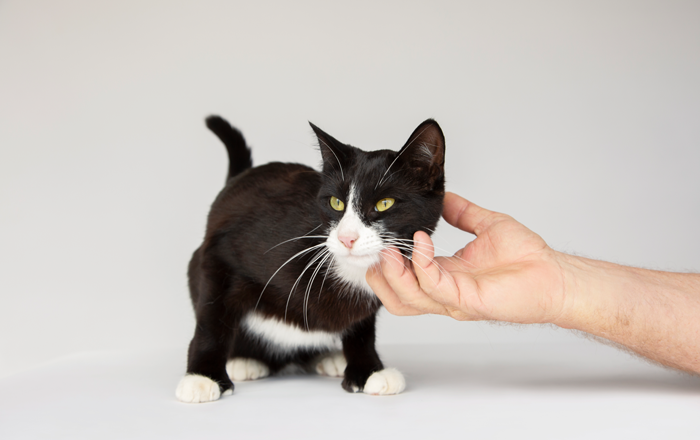
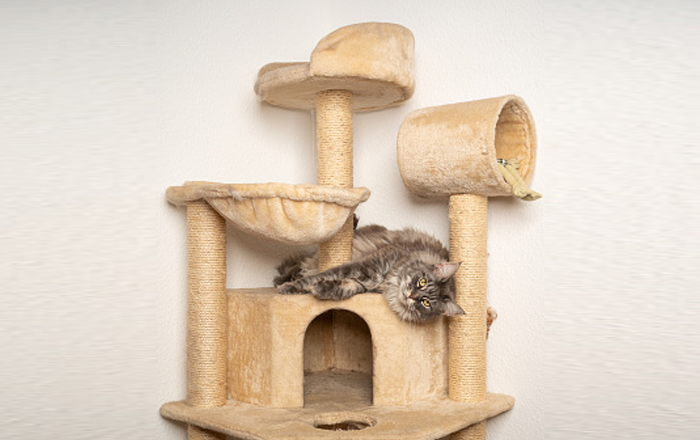
6. Offer safe spaces from Day 1
Cats feel most relaxed when they know they have control over their environment. One of the best ways to support your kitten is to provide safe, cozy hideaways where they can retreat - even the most sociable cats will like this.
Create:
- Covered beds or hideouts in quiet corners
- High-up spaces (shelves, cat trees, cupboards) where they can observe from above
- A quiet, private room with access to food, water, and a litter tray during stressful times (visitors, parties, loud noises)
- A dedicated outdoor “catio” is most ideal, especially if you have more than one cat
Introduce these spaces early, and avoid disturbing your cat when they choose to retreat there.
7. Enrich their world
A bored cat is more likely to develop stress-related behaviours. Enrichment prevents anxiety by giving your cat productive, satisfying things to do and an outlet for natural behaviours. This might include:
- Puzzle feeders and treat-dispensing toys
- Interactive play (e.g. feather wand toys)
- Exploration activities like cardboard boxes and tunnels
- Scent work using hidden treats or herbs like catnip or valerian
Play is one of the best tools for helping your cat develop bond with you, build confidence, and for reducing stress.
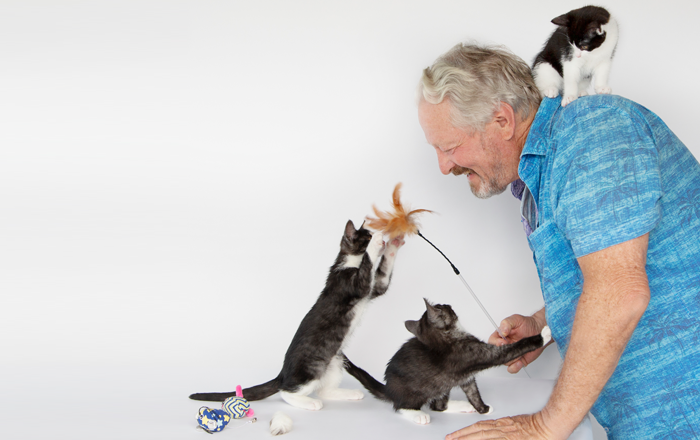
8. Use scent to create familiarity
Cats communicate heavily through scent. You can help them feel safe by:
- Leaving familiar bedding in new areas
- Rubbing a soft cloth on your cat’s cheeks and transferring it to new furniture
- Using feline facial pheromone diffusers (like Feliway) in high-stress areas
These cues help your cat feel like their environment belongs to them, reducing anxiety.
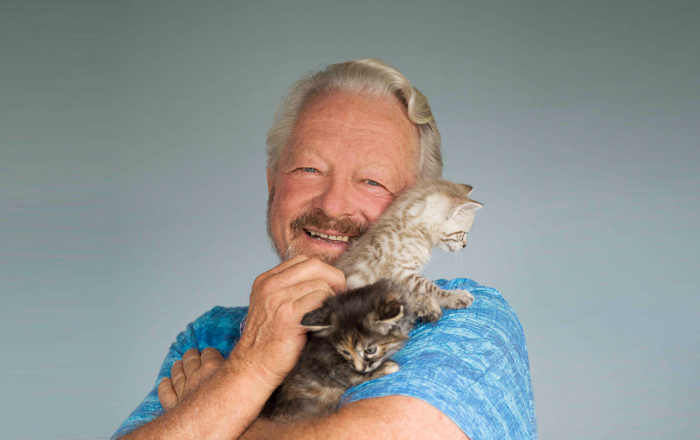
9. Keep calm and consistent
Your energy matters. Cats respond best to calm, consistent routines and low-key interactions.
To help your cat feel secure:
- Feed and play at predictable times
- Avoid dramatic greetings or sudden changes in behaviour
- Use a slow blink or half-closed eyes to signal friendliness
- Speak in soft, low tones and move smoothly
When you act like a calm, confident surrogate mother (which they see you as!), your cat is more likely to mirror that energy.
10. Try harness walking
Walking your cat on a harness provides great physical and mental stimulation while keeping them safe from potential dangers. It’s an especially great option for indoor cats to see and explore the world safely, but it’s also a nice addition to a roaming cat’s life. Many cats (and cat owners!) grow to really enjoy the experience.
Across decades of working with cats, I’ve also found that cats who are harness trained and taken out and about from a young age tend to be more confident, happy and well-adjusted in general life, so it’s a great way to prevent anxiety and build emotional resilience.
As a bonus - it means they are better placed to join you for adventures like family holidays or hikes, and more comfortable going to the vets or groomers!
Final thoughts
Raising a confident, calm cat starts with early, positive experiences, especially during the crucial 3–9 week period. By shaping their environment, building trust through food and training, and providing plenty of early socialisation and exposure to new environments and experiences, you’ll help your cat grow into a relaxed, resilient companion—one who thrives in a busy family home.
And remember: the effort you put in now won’t just prevent anxiety. It will deepen your bond, build emotional resilience and enrich both of your lives for years to come.
Always consult your vet on the best way to look after your pet. And to avoid unexpected costs, make sure your pet is insured.
Have a look at our pet insurance plans to choose the right insurance plan for your pet.
